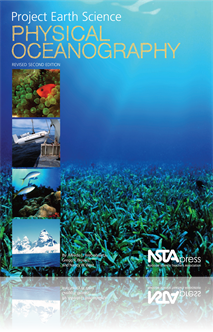All Book Chapters
Book Chapter
In this activity, students will make a series of liquid layers with different densities using nontoxic chemicals. This free activity includes the Teacher Pages and Student Pages for this activity and the Table of Contents, Introduction, and Index...
Book Chapter
Building Models in the Classroom
In this chapter, the author will go into more detail about using MBST in the lab and field, focusing on the practical concerns and techniques of model building in the science classroom. ...
Book Chapter
The Creative Processes of Science
In this chapter, the author examines a way to create new problems for your students to solve in the lab and field. Also looks at ways to stimulate our students to think creatively about the meaning and structure of scientific models in general. Creat...
Book Chapter
MBST and the Scientific Worldview
In this chapter, the author outlines the elements of a model of science in several operational social and personal contexts. Once you developed a model for these contexts, you will look at ways you might ways might contextualize science in your class...
Book Chapter
Can science really provide us with the ultimate answers to life, the universe, and everything? To answer this question and others, we first have to understand models. What are they? How do they work? Why do we use them? Once we have this background, ...
Book Chapter
Mental models provide us with a framework for understanding Models-Based Science Teaching (MBST), as well as some of the tenets and limitations of science suggested by philosophers of science. This chapter is background reading for anyone who wants t...
Book Chapter
This chapter will provide you, as a teacher, with an overview of science: where it comes from, what it is, and how it relates to the MBST model. The chapter begins by defining science and exploring its relationship with its first cousin, technology. ...
Book Chapter
In this chapter, the authors take a look at the three most common forms of communication used in science: verbal, written, and graphical. They will also discuss general guidelines for using communication in an inquiry-based science classroom so that ...
Book Chapter
Because measurements are an important part of inquiry-based science, teachers need to teach measurement skills to their students. Doing so requires a basic understanding of measurement theory and must take into consideration students’ levels of dev...
Book Chapter
Observation is frequently called the most basic of all the scientific skills. Ideally, observations should not include any assumptions, interpretations, opinions, or conclusions on the part of the observer. You should never attempt to explain why som...
Book Chapter
A desire to sort and group objects that have similar characteristics is innate to humans. In science, the process of grouping and organizing items and ideas into categories in accordance with specific rules is known as classification. Scientific clas...
Book Chapter
Scientific Inquiry and Scientific Literacy
This chapter provides an overview of what the authors present in this book as well as how the book is laid out. The authors present a synthesis of research findings drawn from science education, cognitive psychology, and developmental psychology rele...
Book Chapter
To better understand scientific inquiry and how to teach inquiry-based science, full consideration of the uses, purposes, and limitations of models is important. The information presented in this chapter is a summary of important features related to ...
Book Chapter
Scientific Models and Conceptual Change
For children to progress and develop more robust scientific models, they need to evaluate their simple models against the evidence available to them in science, then choose to modify or even abandon their current models in favor of ones that are mo...
Book Chapter
Evaluating Variables, Explanations, and Models
Two components of scientific inquiry—designing tests and analysis—are important parts of most scientific investigations, Designing and carrying out good and fair investigations of scientific models are more difficult than analyzing data and think...
Book Chapter
Problem solving tends to be messy. Every problem is different, and each one calls for a slightly different approach. Unfortunately, students often have erroneous ideas about what it takes to be good at problem solving, such as “good problem solvers...
Book Chapter
Integrating Content and Scientific Inquiry in Your Lessons
Although no single lesson-planning approach will work every time for every student in every situation, researchers continue to conclude that one particular approach outperforms any other when it comes to effectively teaching scientific concepts. This...
Book Chapter
Documentation and Research Paper Setup
After organizing the raw data from your experiment and performing statistical analysis, you are ready to move to the next part of your research project—sharing the results of your experiment. You do this by writing a STEM research paper and/or prep...
Book Chapter
Presenting the STEM Research Project
An important part of conducting research for all STEM professionals is to communicate their study results. This is generally accomplished in two different ways. The first is to write a scientific paper, in order to have the paper published in a STEM ...
Book Chapter
Graphical representations are visual ways to represent raw data, descriptive statistics, or inferential statistics in order to highlight important findings from a research study. You can use the graphical representations to determine additional stati...
Book Chapter
Inferential Statistics and Data Interpretation
This chapter is organized into two parts. In the first part, the author briefly introduces inferential statistical tests that are commonly used in STEM research. The description of these tests is meant only to provide an overview and to help you dete...
Book Chapter
After you have begun background research on your topic and have a preliminary hypothesis, you will write your proposal. A proposal is a document that describes the proposed experimental design of your research project. Essentially, it is a paper writ...
Book Chapter
Once you have collected data from your experiment, you will need to calculate various descriptive statistics explained in this chapter. This chapter contains guidelines on how to graphically represent data and provide tips on using description and in...
Book Chapter
Designing Scientific Tests and Investigations
Designing tests to evaluate scientific models and explanations is one of the hardest—and at the same time one of the most creative—aspects of science. This chapter is devoted to the process of designing tests and investigations to evaluate models...
Book Chapter
Sailors have known for centuries that ocean currents can speed up or slow down a ship. In modern times, scientists have discovered that ocean currents have major effects on climate and weather patterns, and on the ecology of the ocean and nearby land...
Book Chapter
Waves are among the most common phenomena in nature. Waves breaking in the ocean, sound, light, microwaves, radio, or the motion of a guitar cord or a drum are all forms of waves. Such diversity makes finding common properties a challenge but, in ge...
Book Chapter
What are some of the ways you can make waves in water? Have you ever jumped into a pool or lake and done a “cannonball”? This makes waves. The largest water waves on Earth are found in the oceans, and most ocean waves are created by wind. The lar...
Book Chapter
Tanks a Lot—Activities for a Wave Tank (Teacher Demonstration)
Some concepts related to waves, though, are difficult to demonstrate in the classroom. They require observing water waves on a scale that is not ordinarily feasible for the classroom teacher because the necessary equipment is not available. The teach...
Book Chapter
Anyone who has been to the coast realizes there is a rhythm to the ocean. Waves crash onto the beach or rocks. The water they carried washes ashore, then retreats. Another wave crashes ashore. The pattern repeats. However, there is another rhythmic p...
Book Chapter
The Sun, Moon, and Earth are three extremely large objects separated by great distances. Despite the large distances between them, each object affects the others. Earth is kept in orbit around the Sun by the gravitational forces between them. The Moo...
Book Chapter
The Bulge on the Other Side of Earth
The bulge of water on the side of Earth that faces the Moon is easily explained. It is due to the gravitational attraction between the Moon and Earth, including the water on Earth. The difference on the horizontal component of gravity results in wat...
Book Chapter
Telephones, clothing, skis, antihistamines, ballpoint pens, music cassettes, toilet seats, antifreeze, and gasoline: What do these items have in common? All are often made from oil. The United States, like other industrialized nations, bases much of ...
Book Chapter
Hundreds of thousands of boats and ships and the materials and supplies on them have sunk to watery graves since humans first sailed the oceans. Even today, it is common practice for humans to throw their waste into the seas. In the past, much of tha...
Book Chapter
A substance’s molecular structure is responsible for its properties and governs how it interacts with other things on Earth. This Activity introduces and explores one specific property of liquid water. This sample chapter also includes the Table of...
Book Chapter
Water has many peculiar properties: high specific heat capacity, strong ability to act as a solvent, and the ability of the solid phase of water (ice) to float on its liquid phase. Many of the peculiar properties of water are directly related to the ...
Book Chapter
Water is one of the simplest chemical substances on Earth, and yet we must have it to live. In this Activity, you will learn how hydrogen and oxygen join and investigate some characteristics of the bond between them. Knowing the molecular structure o...
Book Chapter
The characteristics of the different parts of the ocean vary depending on the region. While the coastal ocean changes rapidly and presents the largest amount of biological activity, it also shows the largest exchanges with the continents through the ...
Book Chapter
Over and Under— Why Water’s Weird
Understanding water’s molecular structure helps explain some of its characteristics. Density is the mass of an object divided by its volume. In this Activity, you will look at how heating affects the density of different substances....
Book Chapter
The Tides: A Balance of Forces
The interaction between the gravitational forces of Earth, the Moon, and the Sun causes tides. The rhythmic movement of the water associated with the tides causes successive high and low waters in the coastal areas. ...
Book Chapter
Earth’s surface is mostly covered by water. Areas not covered by water—the continents—are surrounded by water. If land and water had the same specific heat, we would expect the land and surrounding water to heat up and cool down at the same rat...







